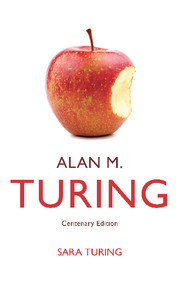Book contents
- Frontmatter
- Contents
- Foreword to the Centenary Edition
- Preface to the First Edition
- Foreword to the First Edition
- Part One Mainly Biographical
- 1 Family Background
- 2 Childhood and Early Boyhood
- 3 At Sherborne School
- 4 At Cambridge
- 5 At the Graduate College, Princeton
- 6 Some Characteristics
- 7 War Work in the Foreign Office
- 8 At the National Physical Laboratory, Teddington
- 9 Work with the Manchester Automatic Digital Machine
- 10 Broadcasts and Intelligent Machinery
- 11 Morphogenesis
- 12 Relaxation
- 13 Last Days and Some Tributes
- Part Two Concerning Computing Machinery and Morphogenesis
- My Brother Alan
- Bibliography
9 - Work with the Manchester Automatic Digital Machine
Published online by Cambridge University Press: 05 April 2012
- Frontmatter
- Contents
- Foreword to the Centenary Edition
- Preface to the First Edition
- Foreword to the First Edition
- Part One Mainly Biographical
- 1 Family Background
- 2 Childhood and Early Boyhood
- 3 At Sherborne School
- 4 At Cambridge
- 5 At the Graduate College, Princeton
- 6 Some Characteristics
- 7 War Work in the Foreign Office
- 8 At the National Physical Laboratory, Teddington
- 9 Work with the Manchester Automatic Digital Machine
- 10 Broadcasts and Intelligent Machinery
- 11 Morphogenesis
- 12 Relaxation
- 13 Last Days and Some Tributes
- Part Two Concerning Computing Machinery and Morphogenesis
- My Brother Alan
- Bibliography
Summary
On resignation from the Scientific Civil Service Alan accepted a Readership at Manchester University and was appointed Assistant Director of “Madam,” the Manchester Automatic Digital Machine designed mainly by Professor F.C. Williams, F.R.S., and Dr. T. Kilburn. This machine at the time of its construction was reputed to have the largest memory storage capacity of any known machine and was expected to be able to “remember” a bookful of facts and figures.
As Assistant Director (but ignorant himself of the identity of the Director) Alan's role was to collaborate with Professor F.C. Williams and Dr. T. Kilburn and lead the mathematical side of work with the machine. According to Professor M.H.A. Newman's account in the Royal Society's Memoir, “for a few years he continued to work first on the design of the sub-routines out of which the larger programmes for such a machine are built, and then, as this kind of work became standardized, on more general problems of numerical analysis.” With the experience so gained he produced in 1950, The Programmers' Handbook for the Manchester Electronic Computer.
In June 1949, a representative of The Times asked him by telephone sundry questions and put forward certain propositions regarding the scope of the machine; in reply Alan hazarded some forecasts of what the machine might eventually achieve. He was aghast a day or two later to find the results of this telephone conversation expanded into a long paragraph on the centre page of The Times.
- Type
- Chapter
- Information
- Alan M. TuringCentenary Edition, pp. 88 - 99Publisher: Cambridge University PressPrint publication year: 2012



